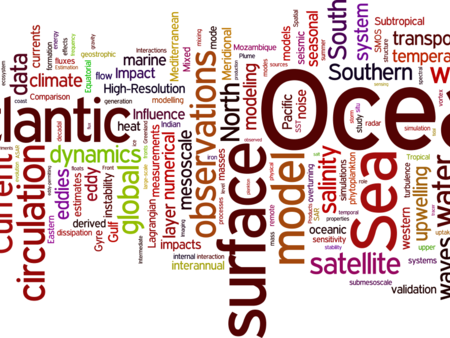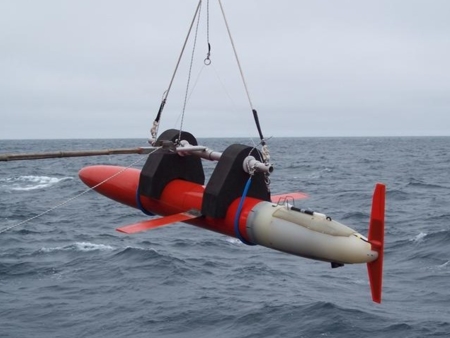Interaction between multi-decadal variability and meso-scale eddy turbulence
The variability of the climate on time scales of a few decades is driven by intrinsic fluctuations as well as by anthropogenic forcing. Our lack of knowledge of the dynamics behind this natural variability prevents us from making accurate climate predictions which are a very strong societal need. Studies suggest that uncertainty in natural climate variability is larger than that in anthropogenic forcing for the predictions of climate changes over the next decades. The slow oceanic circulation likely plays a central role on decadal time scales because it is on these scales that the top 1000 m of ocean adjusts. Inter-decadal oceanic variability has been observed for instance in sea surface temperature and sea level data of the North Atlantic during the last century . This mode of variability has been called the Atlantic Multidecadal Oscillation (AMO)6 and is well correlated with Climate variations. Indeed, for instance US continental rainfall is less important during a positive AMO phase than during a negative phase, and AMO is highly correlated with Sahel rainfalls and hurricane intensity in the Atlantic. Thus a better understanding of the oceanic low frequency variability will allow better climate predictions everywhere and in particular in Europe. In the ocean, the large scale low frequencies currents take the form of what have been called “Oceanic Basin Modes” which are the solution to the linearized dynamical equations around a mean state.
The ocean internal modes also link a spatial pattern to a period of oscillation and to a damping or growing (because of baroclinic instability) coefficient. Inter-annual timescales and basin modes are deeply linked to the propagation of long Rossby waves observed in altimetric data8 that transport energy 9 from the east to the west at a rate that depends mainly on latitude, stratification and mean currents . The interaction of those waves with the western coastline partitions the energy into reflected short eastward Rossby waves and rapidly propagating ageostrophic motions along the boundary (coastline+equator) that, in turn, restart the Rossby waves at the eastern boundary. This process creates the weakly damped basin modes with decadal frequencies.
In steadily forced, idealized low-resolution ocean models, low-frequency time-dependence occurs spontaneously as unstable baroclinic Rossby waves and experiments show that these waves persist in coupled ocean atmosphere models and in models with higher spatial resolutions. This results suggest that the low frequencies are driven by large-scale baroclinic instability. However, others studies do not report any growing basin-mode and therefore outline that the growing or damped coefficient of modes are quite sensitive to the settings of the model under consideration. The most critical parameter controlling the growth of the basin mode appears to be the temperature horizontal diffusivity which represents the effect of unresolved mesoscale eddies on large scale temperature mixing.
Huck 2015 speculated that because the range of vertical diffusivity coefficient allowing the existence of the low-frequency mode is larger at eddy-resolving than at low resolution, the eddy field may in fact act as a stochastic excitation of the low-frequency mode. This idea is reminiscent of the studies of Frankcombe et al. 2009 and Sevellec et al. 2009 who suggested that the SST multidecadal temperature variability could be explained by a damped oceanic mode forced by atmospheric noise.
A recent series of studies Arbic et al. 2014, Serazin et al. 2015, O’Rourke et al. 2018, Serazin et al. 2018 further suggests that meso-scale eddies undergo what has been called a « temporal inverse cascade of kinetic energy ».
This cascade is reflected in a transfer of kinetic energy from the high frequency meso-scale eddy field to lower frequencies and seems to support the idea of a possible forcing of the low frequency mode by meso-scale eddies.
However there seems to be a contradiction between the idea that diffusion, which parametrizes the effect of eddies, is a sink of temperature variance and that eddy turbulence might also be a source term for the low frequency mode.
In this project we seek to better understand the interaction between the low frequencies associated with multi-decadal large scale variability and the high frequencies associated with mesoscale eddy turbulence.
The mode's existence was first shown in a rectangular flat-bottomed single-hemispheric basin, with prescribed surface heat fluxes and Planetary Geostrophic dynamics (Greatbatch 1995). As explained above, in this configuration, a large scale baroclinic instability continuously feeds large scale planetary waves (Colin de Verdiere & Huck 1999). The planetary waves give rise to SST and Meridional Overturning Circulation variability. Figure 1 shows the variability that spontaneously emerges in this configuration.
Our approach is to simulate the large scale mode using this relatively simple configuration and to add a mesoscale eddy turbulence field by employing the MITgcm (an Ocean General Circulation Model) at eddy-resolving resolution. We then develop diagnostics of temperature variance budget and energy (Available Potential Energy and Kinetic Energy) budget for different frequency bands. Constructing these budgets allow to identify sources and sinks of low frequency variability as well as transfers between different temporal scales. Figure 2 shows an example of such a decomposition for the temperature variance.







